- CFD, Fluid Flow, FEA, Heat/Mass Transfer in Process Industry
Process Industry
Applications of CFD tools in process industry
Phenomena in process industry
Process industry deal with wide range of tasks comprising mixing, emulsifications, chemical reactions, combustion, heat transfer in all three modes namely conduction / convection / radiation, phase separation...
Categories of Equipments
- Static Equipment: As the name suggests, there are no moving parts inside these components except moving fluid. The components falling under this category are pressure vessels, heat exchangers, tanks and filters, separators. Heat Exchangers are of the types: Air coolers and economizers, Plate and Frame, Spiral Plate, Shell and Tube, Plate-fin, Fired Heaters, Jacketed Pipe and Hair-pin.
- Rotating Equipment: The components falling under this category contains rotating parts and are primarily meant to move fluids. PRotating Equipment typically includes equipment like gas turbines, steam turbines, turbo-pumps, compressors, fans, motors, centrifuges... These equipment are distinguished by the rotating motion caused by impellers or rotors. In addition to the study of fluid and heat transfer phenomena, the effect of fluid on structural integrity of these parts is also important. Fluid-induced instabilities are one such phenomena which needs to be investigated.
- Fired Equipments: These are equipments which deals with combustion phenomena such as Furnaces, boilers, economizer
- Material Handling Equipment: cranes, hoists, conveyor systems and pulleys, Condensate tower, Vacuum tower, debutanizer, sour water stripper tower
Oil and Gas Industry
| Industry Segment | Main Operations | Players |
| Upstream | Oil exploration and owning of oil fields | Shell, ExxonMobil |
| Midstream | Field gathering (storage from thousands of bore wells), transmission pipelines, transportation vessels, processing plants | Halliburton, Reliance |
| Downstream | Distribution network for consumers: retail and industrial (e.g. aviation) | OMC: Oil Marketing Companies |
Spray Drier
Spray dryers haveconsiderable importance in many industrial drying operations such as in food, detergent, minerals and pharmaceutical product processing. The key issues in dryer operation are- Flow stability to avoid highly unsteady flows. Flow regimes of later typer can lead to significant wall deposition of partially dried product which sticks to the wall, resulting in a build up of crust.
- There are large scale drifting of droplets if the inlet flow is not swirled and regular precession occurs if there is inlet swirl
- Droplets in spray dryers contain solids and therefore modeling droplet evaporation should account for hindered drying due to the presence of the solids
- Amount of drying in most spray dryers is limited by equilibrium between the outlet gas and the dried particles as well as the particle drying kinetics
- Other important aspects of dryer operability are the accumulation of droplets/particles on the dryer walls or in the exit regions, particle agglomeration where near the nozzle liquid droplets coalesce but near the exit the partially dried solids can agglomerate.
- Almost all spray dryer modelling is performed using a mixed Eulerian/Lagrangian approach with single phase Reynolds Averaged Navier Stokes (RANS) equations are solved to determine the flow field.
- The phenomena is transient and three-dimensional in nature which require transient (time accurate) simulation methods
- The discrete phase, the wet droplets, are modelled using the Lagrangian technique and iterative coupling between the conservation equations for mass, momentum and energy is required because of the high inter-phase transfer rates.
- In transient simulations, droplets needs to be tracked for each timestep along with storing positions and state (temperature, velocity, dryness) of the droplets. The injection of droplets are made at the inlet at each timestep.
Jet Break-up
Excerpts from "REEVALUATING THE JET BREAKUP REGIME DIAGRAM" by Ben Trettel, University of Texas at Austin: "Breakup of Newtonian jets injected into still low density environments without considering cavitation, Mach number effects or evaporation, there are many varieties of jet breakup. Which regime a jet is in depends on factors including but not limited to the Reynolds number, Weber number, the liquid-gas density ratio and the turbulence intensity." 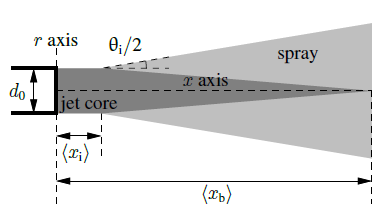
- d0 = nozzle outlet diameter,
- xi = average breakup onset location
- θi = spray angle and
- xb = breakup length.
- Dripping regime: The jet velocity is so low that breakup is driven by gravity, producing relatively large droplets.
- Rayleigh regime: Breakup due to a surface-tension-driven instability resulting in droplets larger than the nozzle outlet diameter but of the same order of magnitude. The breakup length increases with increasing jet velocity.
- First wind-induced regime: Droplet diameters are on the order of the nozzle outlet diameter (Lin and Reitz). The breakup length decreases with increasing jet velocity in this regime (Reitz, 1978).
- Wind-induced regime: The droplet diameters are smaller than the nozzle outlet diameter. The average breakup onset location is not negligible, but can be small. The breakup length increases in a power law with increasing jet velocity.
- Atomization regime: Droplet sizes are much smaller than the nozzle outlet diameter, defined frequently as breakup starting at the nozzle outlet
Primary atomization of the liquid jet occurs near the outlet of the nozzle. Turbulent fluctuations of the liquid jet induce perturbations on the jet surface, which grow and break the jet into droplets. The length scale of turbulence is the dominant length scale of atomization, which also determines the resulting droplet size (Chryssakis et al.)1.
2In the plain-orifice atomizer model, the operation mode of the nozzle is determined based on the Reynolds number, the cavitation number and the critical values for the inception of cavitation and flipping (ANSYS, 2016). The Reynolds number based on hydraulic head is defined as ReH = (D ρL / μ) [2(p1 − p2)/ρL]0.5 where D is the nozzle diameter, ρL is the liquid density and μ is the liquid viscosity. The upstream and downstream pressures are denoted by p1 and p2, respectively. The cavitation number is defined as K = (p1 − pv)/(p1 − pv) where pv is the vapour pressure of liquid at operating temperature. For short, sharp-edged nozzles, the inception of cavitation occurs approximately at cavitation number K ~ 1.9.1Chryssakis, C.A., Assanis, D.N. and Tanner, F.X., 2011. Atomization Models, in Handbook of Atomization and Sprays, Ed. N. Ashgriz, Springer, New York, USA.
2ANSYS Fluent Theory Guide, section Atomizer Model Theory
Check Valves and Non-Return Valves
In general discussions, the designations ‘non-return valve’ and ‘check valve’ are used to mean the same device. However, as per "Heating and Plumbing Monthly" magazine, "There are legal requirements to use only check valves for backflow prevention. Fundamentally – check valves (CVs) and non-return valves (NRVs) are different fittings and serve different purposes. Under UK plumbing regulations, the check valve has a specific purpose as a device legally permitted to be used to prevent backflow in defined circumstances. The non-return valve, while useful for preventing reverse flow in pipes in many situations, is not a recognised backflow prevention device."
As per "hpmmag.com/training-and-technical/check-valves-and-non-return-valves":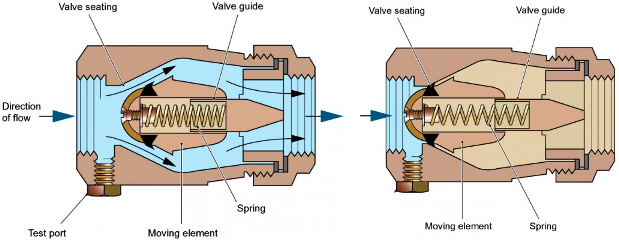
Spool Valve
Reference: Flow-Force Analysis in a Hydraulic Sliding-Spool Valve by Niko Herakovic - 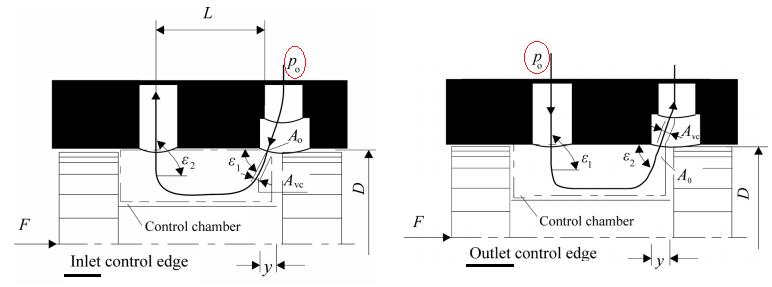
The stationary share of the flow force for the inlet edge can be calculated from the axial momentum component as per equation (1). The non-stationary share of the flow force [necessary to accelerate the fluid mass in the slidingspool chamber] can be calculated using the length L of the accelerated oil quantity in the control volume of the sliding-spool chamber as per equation (2):

Safety Valves
The most widely used way to classify safety relief valves [SRV] is from the acting load on the valve disc.- direct spring-loaded safety valve, majority of cases in the industrial use
- weight loaded safety valve such as pressure cookers
- pilot operated safety valve - maintains constant pressure in a hydraulic system and is frequently used in precision hydraulic control systems
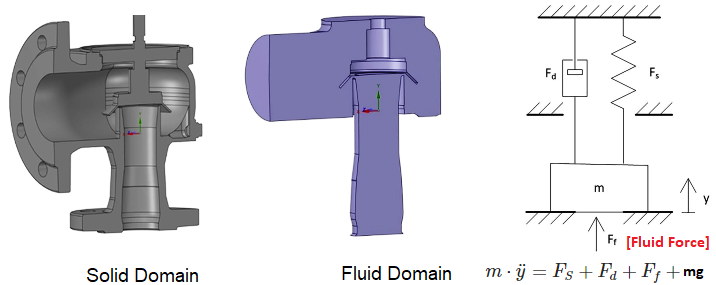
Reference: A CFD analysis of the dynamics of a direct-operated safety relief valve mounted on a pressure vessel by Xueguan Song et al. The motion of the valve disc is determined based from a force balance at all times which is governed by Newton's second law of motion resulting in second-order ordinary differential equation. Flow is mainly controlled by the opening between the nozzle and the disc until the disc attains the maximum lift. As the fluid is exhausted through the SRV, the average pressure inside of the vessel decreases proportionally consequently the lift force also reduces.
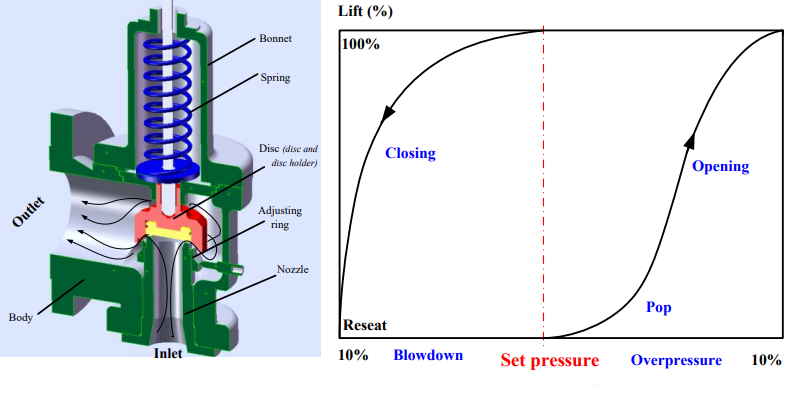
The content on CFDyna.com is being constantly refined and improvised with on-the-job experience, testing, and training. Examples might be simplified to improve insight into the physics and basic understanding. Linked pages, articles, references, and examples are constantly reviewed to reduce errors, but we cannot warrant full correctness of all content.
Template by OS Templates